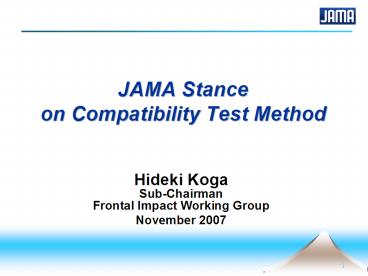JAMA Stance on Compatibility Test Method - PowerPoint PPT Presentation
1 / 10
Title:
JAMA Stance on Compatibility Test Method
Description:
on Compatibility Test Method. Hideki Koga. Sub-Chairman. Frontal Impact ... Test ... Test/assessment methods are considered taking into account ... – PowerPoint PPT presentation
Number of Views:142
Avg rating:3.0/5.0
Title: JAMA Stance on Compatibility Test Method
1
JAMA Stance on Compatibility Test Method
Hideki Koga Sub-Chairman Frontal Impact Working
Group
November 2007
2
1. Short-term Strategies
(1) Views in Japan on the compatibility issue
A new regulation reflecting comments from the
Council for Transport of MLIT will be established
in the near future.
08
09
10
11
12
Regulation (Phase 1)
Japan
Assessment
JAMAs position on compatibility
Arrangement of side members is important.
3
Matching the geometry of the frame is most
important.
4
(2) Test/assessment methods
The following three proposals are currently under
discussion with MLIT
- (A) Alignment of geometry (equivalent to US TWG
voluntary regulation) - Front side members must geometrically be within
the Part 581 zone. - Alternatively, SEAS must be employed.
- (JAMAs proposal 1)
- (B) Assessment with forces using multiple load
cell barrier - A standard will be set for the force applied on
rows 3 and 4. - (JAMAs proposal 2)
- (C) Assessment with AHOF
- AHOF must be within the Part 581 zone.
- Alternatively, SEAS must be employed.
- (Under NHTSA Research , which JAMA opposes)
5
(A) Alignment of geometry (equivalent to US TWG
voluntary reg.)
? Matching the geometry of the frame is most
important.
Direct geometrical measurements shall be taken.
Front side members must be within the Part 581
zone otherwise, SEAS having a certain strength
must be provided.
? Tasks
To develop a standard than can properly assess
any frame.
e.g. Which height should be measured?
Valid standard is necessary currently under
consideration.
?
SUVs trucks are covered in US regulation.
In Japan, supermini cars are also included
More complex than trucks
6
(B) Assessment with forces using multiple load
cell barrier
? Method of measuring the height of side members
is being developed.
Set target loads for rows 3 and 4.
? Tasks
To ensure accurate detection of the position of
the frame irrespective of the influence of the
engine or auxiliary machines.
Rigid wall
Loads of this part are specified.
7
Assessment is conducted by frontal collision with
FWRB and AHOF obtained. AHOF400 must be within
the Part 581 zone. Alternatively, SEAS must be
employed.
(C) Assessment with AHOF
? Under NHTSA Research
Upper end
Lower end of side MBR
380
356
? Reasons for JAMAs opposition
AHOF
1. Some AHOF values can clearly deviate from the
frame position.
Vehicle A
Vehicle B
2. The correlation between AHOF and actual
accident conditions seems weak (AM values).
Aggressivity Metric
Driver Fatalities in collision partner
(Number of Crashes of subject vehicle)/1000
3. The validity of AHOF has not been globally
proved. MLITs assessment may be inappropriate in
the long term.
Correlation coefficient AM vs AHOF
8
2. Long-term Strategies (consideration of future
test/assessment methods)
Test/assessment methods are considered taking
into account stiffness matching in addition to
geometric matching.
KW400
MDB
PDB
PDB
Honeycomb
Barrier force
Inclination
Amount of car crush
400mm
9
3. Summary
(1) Short-term strategies
- Arrangement of side members is important
- For proper assessment of the above, the
following 3 proposals are being discussed
(A) Alignment of geometry (equivalent to US TWG
voluntary regulation) (B) Assessment with forces
using multiple load cell barrier
(C) Assessment with AHOF
(2) Long-term strategies
Since matching of both geometry and stiffness is
important, test/assessment methods which can
check the matching properly will be developed.
10
Thank you.































